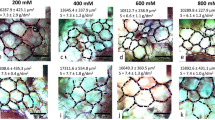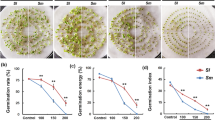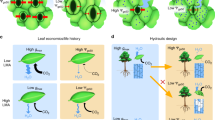Abstract
IT is well known that xeromorphy is of physiological importance1 to the aquatic plants which exhibit it and certain tissues become altered in relation to environment. The modifications in internal leaf structure include a higher stomatal frequency. Limited enlargements of epidermal cells result in the increase in number of stomata per unit area. Though these are the features of a xerophyte, experimental evidences to show the stomatal distribution in relation to xeromorphy exhibited by an aquatic plant are meagre. In an attempt to elucidate the problem of xeromorphy in aquatic plants the wild species of Ipomoea carnea Jacq growing in different ecological habitats, that is, aquatic and xerophytic, was selected. The aquatic plants were selected from those growing at a 3–5 ft. depth of fresh-water in ponds and ditches and the xerophytic plants from those growing in the sandy soils of the plains. Though these plants belong to the same species they are not alike but have become adapted through generations of growth in the particular habitat. We consider that a comparison between the same species which has grown naturally under different ecological habitats might better contribute towards our understanding of the nature of xeromorphy than inducing xeromorphy under artificial conditions. The species considered here is a straggling shrub with milky juice and ovate-cordate leaves with large convolvulaceous pink flowers. The plant grows abundantly both in dry and marshy places besides its aquatic habit in various parts of India.
This is a preview of subscription content, access via your institution
Access options
Subscribe to this journal
Receive 51 print issues and online access
$199.00 per year
only $3.90 per issue
Buy this article
- Purchase on Springer Link
- Instant access to full article PDF
Prices may be subject to local taxes which are calculated during checkout
Similar content being viewed by others
References
Yapp, R. H., Ann. Bot., 26, 815 (1912).
Gupta, B., Ann. Bot., N.S., 25, 71 (1961).
Author information
Authors and Affiliations
Rights and permissions
About this article
Cite this article
MOHANTY, P., MISHRA, D. Stomatal Distribution in Relation to Xeromorphy in Aquatic Plants. Nature 200, 909–910 (1963). https://doi.org/10.1038/200909b0
Issue Date:
DOI: https://doi.org/10.1038/200909b0
This article is cited by
-
Prasanna K. Mohanty (1934–2013): a great photosynthetiker and a wonderful human being who touched the hearts of many
Photosynthesis Research (2014)
-
Growth behaviour of the invasive species Ipomoea carnea in the Nile Delta, Egypt
Hydrobiologia (2010)
Comments
By submitting a comment you agree to abide by our Terms and Community Guidelines. If you find something abusive or that does not comply with our terms or guidelines please flag it as inappropriate.



